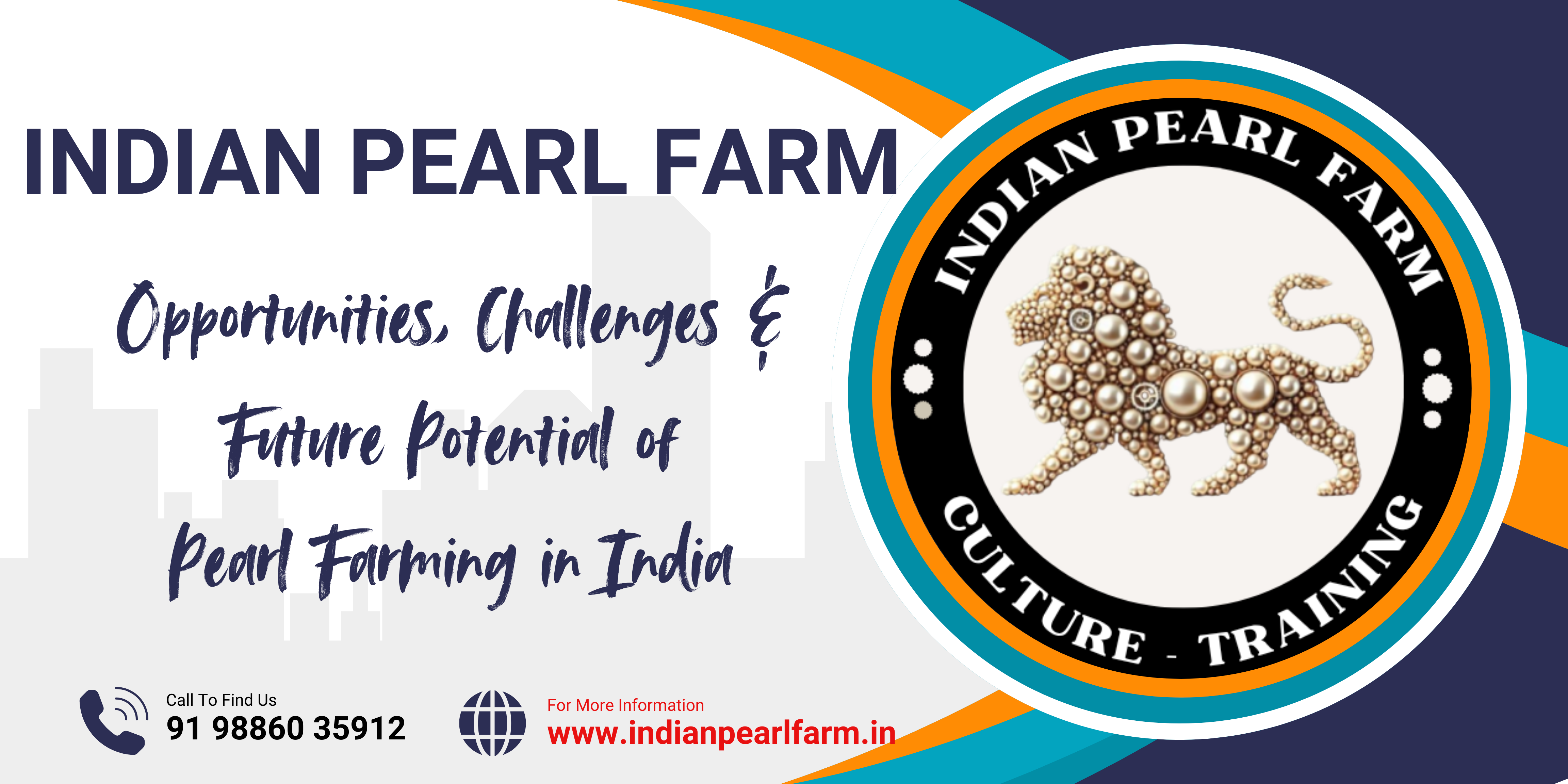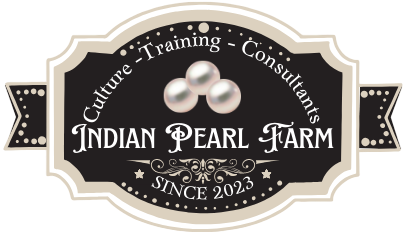
Pearl Farming in India – Opportunities, Challenges, and Future Potential
Institutions such as Indian Pearl Farm are leading the way in training, research and awareness creation. By blending scientific knowledge with practical hands-on experience, they enable farmers, students and entrepreneurs to embrace pearl farming as a sustainable and profitable livelihood. This article explores the history, cultural significance, economic opportunities, challenges, government policies, career prospects and future outlook of pearl farming in India — with emphasis on strategic and commercial perspectives rather than technical procedures.
Pearls in Indian History and Culture
Pearls are deeply woven into India’s cultural and historical fabric. References to pearls appear in Vedic texts, classical Sanskrit literature and ancient scriptures. The Rigveda and later works link pearls to purity, prosperity and divine connection. In Ayurveda pearls were used in powdered form for certain formulations, believed to have curative properties.
Mythological narratives — including the legend of Samudra Manthan (the churning of the ocean) — list pearls among the celestial treasures that emerged from the sea. Royalty and nobility across Indian history prized pearls: Mughal emperors, Deccan kings and South Indian maharajas adorned crowns, necklaces and garments with pearls. The Gulf of Mannar and the coastal belts of South India were historical sources of natural pearls, while Hyderabad earned the moniker “City of Pearls” for its vibrant trade.
Although natural pearls are rare today, the cultural fascination with pearls endures. Bridal sets, temple ornaments and contemporary fashion continue to feature pearls, which positions India as a high-value domestic market for cultured pearls.
The Global Pearl Industry
Understanding global dynamics is essential to appreciating India’s opportunity. Japan modernized cultured pearl production in the early 20th century and set global standards in quality. China has since emerged as the largest freshwater pearl producer, supplying large volumes of affordable, consistent quality pearls to global markets. Myanmar, Australia and the Philippines are noted for premium saltwater and South Sea pearls.
The global pearl sector is a multi-billion dollar industry. Shifts in consumer preferences — including demand for sustainable and organic gems — favor cultured pearls, which are renewable and produced with low environmental impact compared to mined gemstones. India, with its large jewelry market and cultural affinity for pearls, is well placed to capture a significant share of this expanding market if production, quality control and market linkages scale up effectively.
Indian Scenario: Scope and Opportunities
India’s potential in pearl cultivation emerges from three interlinked factors: natural resources, market demand and entrepreneurship potential.
Natural Resources
India’s inland water bodies — rivers, tanks, reservoirs and ponds — provide a widespread platform for freshwater pearl farming. States such as Karnataka, Tamil Nadu, Odisha, West Bengal and Bihar possess ecological zones suited to mussel culture. Freshwater pearl culture does not require coastal access, making it accessible across many Indian geographies and enabling decentralized rural entrepreneurship.
Growing Market Demand
India’s domestic demand for pearls is driven by weddings, festivals and fashion. The expanding middle class and rising disposable income further bolster consumption. Locally produced cultured pearls have the potential to reduce import dependence and make pearls more affordable while retaining higher margins for domestic producers.
Entrepreneurial Scope
Pearl farming extends beyond cultivation into processing, grading, jewelry manufacturing, retailing and export. This value chain creates opportunities for small entrepreneurs, women’s self-help groups, designers and exporters. It is attractive to professionals from diverse backgrounds — including students and tech professionals — who seek an alternative or second career rooted in sustainable agribusiness.
Economics of Pearl Farming (Strategic Perspective)
Even without describing the on-farm technical steps, it is important to understand the economics involved in pearl culture to frame viable business models.
Capital and Operating Considerations
Initial capital requirements are relatively modest for small to medium operations compared to many other agri-enterprises. Core investments include land or pond rental/preparation, basic infrastructure, broodstock procurement, tools and skilled labor/technical training. Operating costs include feed and water management inputs, labor, and periodic health/quality monitoring.
Revenue Streams
Primary revenue comes from pearl sales; secondary revenues can be realized by selling shells for handicrafts, providing training services, or developing value-added jewelry and branded products. Designer pearls and niche religious/ceremonial pearls can command premium prices.
Profitability & Break-Even
Return on investment depends on survival rates, pearl quality distribution, effective grading, and market access. Well-run farms with access to technical support and market linkages can recover investments within 2–3 years and generate significant margins thereafter. The business is attractive because the capital depreciates slowly and value addition through processing and branding multiplies returns.
Employment and Local Economy
Pearl farms create jobs — from technicians and caretakers to marketers and jewelers. They stimulate local economies through ancillary activities: feed supply, equipment services, processing units and tourism/educational visits. This makes pearl farming a catalyst for rural entrepreneurship and value chain development.
Challenges and Risks in the Indian Context
Pearl cultivation’s promise is counterbalanced by several structural challenges that need strategic solutions:
Awareness and Perception
Many prospective farmers and entrepreneurs are unaware of pearl culture as a mainstream livelihood. Cultural inertia and risk aversion mean adoption lags despite potential returns.
Skills and Training Gaps
Technical skills in broodstock selection, quality control and post-harvest grading are limited in many regions. Short-term workshops without hands-on follow up lead to high mortality and poor yields. Effective capacity building requires practical training centres, on-farm apprenticeships and long-term mentorship.
Market Linkages & Price Realization
Even when pearls are produced, lack of organized market channels and weak branding capabilities reduce price realization. Producers often sell to middlemen at low margins. Strengthening direct channels with jewelers, exporters and e-commerce platforms is essential.
Quality Standards and Certification
Global buyers demand consistent quality and traceability. India lacks a widely recognized certification framework for domestic pearls, which can limit export potential. Developing quality standards, traceability and branding will increase buyer confidence.
Financial & Policy Limitations
Access to affordable credit, insurance for aquaculture risks, and targeted subsidies are still evolving. While certain schemes exist, more tailored financial instruments and policy clarity will accelerate adoption.
Role of Training and Research Institutions
Institutions like Indian Pearl Farm can bridge gaps by combining applied research with market-ready training models. Key roles include:
- Practical Training: Hands-on learning with live demonstrations and supervised practice ensures trainees acquire applicable skills.
- Post-Training Mentorship: Follow-up guidance during the first production cycles reduces failures and improves survival rates.
- Market Linkages: Facilitating connections with jewelry designers, local retailers and exporters enables better price discovery.
- Applied Research: Local trials on species selection, feed regimes and quality enhancement adapt global best practices to Indian contexts.
- Incubation & Business Support: Helping trainee entrepreneurs with business plans, funding guidance and branding accelerates commercialization.
Government Support, Policies and Financial Instruments
Government agencies and financial institutions have a key enabling role. Existing schemes and institutions relevant to pearl culture include:
- National Fisheries Development Board (NFDB): Promotes aquaculture technologies and farmer awareness programs.
- NABARD and Agri-finance: Source of credit lines and rural development finance for aquaculture projects.
- State Fisheries Departments: Some states run pilot projects, provide seed support and technical advisory services.
- Skill Development Programs: Vocational training initiatives can incorporate pearl culture modules to increase adoption among youth.
To scale responsibly, policy attention must focus on tailored subsidies, risk-mitigation insurance, export promotion and a quality certification framework for cultured pearls.
Career and Entrepreneurship Opportunities
Pearl culture is a versatile sector that offers pathways for multiple career profiles:
For Students and Young Entrepreneurs
Hands-on training equips students with technical and entrepreneurial skills. Start-ups can leverage low capital entry points to build farm-to-jewelry ventures and niche brands.
For Professionals and Career Shifters
Tech professionals and corporate employees facing uncertain job markets may find pearl farming an attractive second career or side business. The sector offers meaningful work, nature-based lifestyle and opportunities for high returns with diligent management.
For Women and Community Groups
Women’s self-help groups can engage in the processing, design and retail segments of the pearl value chain — adding value locally and generating stable incomes.
For Designers and Exporters
Access to domestically produced pearls allows jewelry designers to innovate with locally sourced raw materials and appeals to buyers seeking ethically traceable products.
Success Models & Case Studies (Strategic Examples)
Across India, pilot practitioners and small entrepreneurs have shown encouraging success by combining training, small pilot farms and market focus. Key common factors in successful models include:
- Rigorous practical training and on-farm mentorship.
- Small pilot runs to validate economic assumptions before scaling.
- Strong local market networks and direct relationships with retailers and designers.
- Branding based on traceability and eco-friendly practices.
These success stories underline that with the correct blend of technical help, business support and patience, pearl farming can be profitable and scalable.
Sustainability and Environmental Considerations
Sustainability is intrinsic to cultured pearls: they are organic products produced from living organisms. Sustainable practices promote long-term viability and market advantages:
- Emphasizing low-impact aquaculture practices to preserve water quality and biodiversity.
- Using local species and minimizing introductions of non-native organisms.
- Promoting integrated livelihoods (shell handicrafts, agritourism) that add value without increasing environmental stress.
Sustainability-focused pearls command higher premiums in environmentally conscious markets and support community resilience.
Branding, Certification and Market Positioning
To reach higher value markets — especially international buyers — Indian producers must focus on:
- Quality control and standardized grading systems.
- Traceability documentation that proves origin and sustainable practices.
- Brand stories that link product, place and social impact.
- Design collaborations with recognized jewelers and designers.
A concerted push toward branding and certification will raise India’s credibility as a pearl origin and open export channels to discerning markets.
Future Outlook: Scaling India’s Pearl Movement
India’s path to becoming a major pearl producer will depend on coordinated efforts across multiple fronts:
- Capacity building: Practical training centres and incubation hubs to create a skilled workforce.
- Policy support: Financial instruments, targeted subsidies and export facilitation.
- Market development: Strengthening B2B and B2C linkages, e-commerce channels and brand incubation.
- Innovation: Designer pearls, small-batch artisanal lines and value added processing.
- Research: Local R&D to improve yield, quality and species adaptation to Indian conditions.
With these enablers, India can move from being a net importer to a competitive producer and exporter of cultured pearls.
Conclusion
Pearl farming in India is much more than an agricultural novelty — it is an avenue for rural upliftment, entrepreneurial growth and cultural continuity. By focusing on practical training, market linkages, quality standards and sustainable practices, India can harness pearl cultivation as a resilient and profitable sector.
Institutions such as Indian Pearl Farm play an essential role by training individuals, incubating entrepreneurs and helping create market pathways. With policy support, investment in research and strong branding, India has the potential to become a recognized name in the global cultured pearl market.
Contact & Further Information
Indian Pearl Farm
Website: www.indianpearlfarm.in
Phone: +91 9886035912


0 Comments
No comments yet. Be the first to comment!